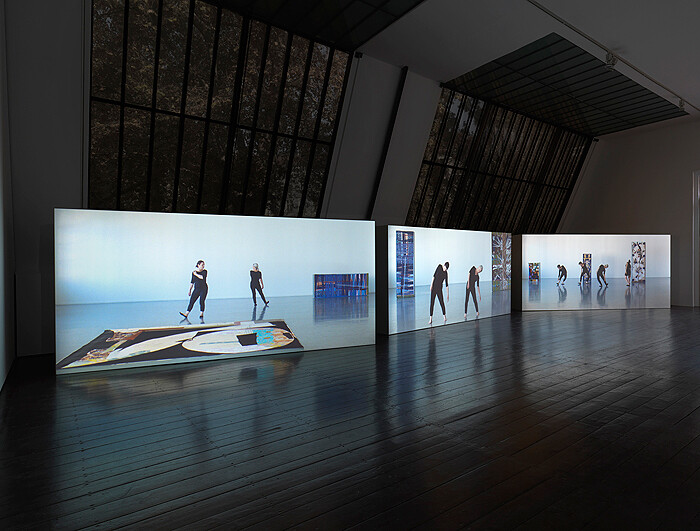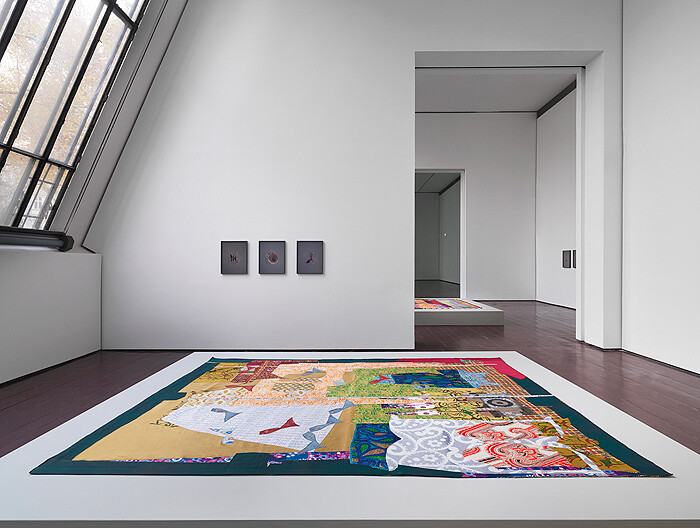Four women stand in a light-flooded room, barefoot and dressed in simple black. The youngest is in her early thirties, the oldest in her early seventies. A metronome is turned on to an eager 120 beats per minute. One of the dancers counts in Hebrew softly, “Achat, shtaim, shalosh, arba,” as they start moving in perfect synchronicity and balance. One wrong move and they all stop and start over. The metronome never stops ticking.
Located in Vienna’s second district, and in the oldest Baroque gardens in the city, a spacious four-room exhibition space with sloping north windows serves as Thyssen-Bornemisza Art Contemporary’s gussy new venue. Here, its second show is dedicated to Sharon Lockhart (born 1964) who, in turn, made her subject the vast legacy of work left behind by Israeli dance composer Noa Eshkol (1924–2007). A few months after Eshkol’s death, during a trip to Israel in 2008, Lockhart stumbled upon a time capsule of work that the dancer left in Holon, a suburb of Tel Aviv. From the mid-1950s until her death in 2007, this was the place where she created and practiced the Eshkol-Wachman Movement Notation system (EWMN) together with architect Avraham Wachman (1931–2010). As a former student of Rudolf Laban (whose movement analysis she found to be too metaphorical and personal), Eshkol invented notation system that records the movements of our limbs so that choreographies—and movement in general—can be written down like musical scores.
Next to an extensive public program where visitors—among many other things—can attend “open practices” to see the Noa Eshkol Chamber Dance Group rehearse and perform the EWMN, the exhibition is a composition of Lockhart’s interventions in Eshkol’s work and ideas: she filmed the dancers performing the scrupulous notations; selected some of Eshkol’s tapestries to be included in the show; and photographed Eshkol’s “sculptures”—some seven three-dimensional spheres that Eshkol created as models to visually frame the EWMN technique. Across the main gallery, a small white building called the TBA21 Kiosk provides space for some archival photographs, notes, and letters by Eshkol and displays the show’s second single-channel film installation. The piece, entitled Four Exercises in Eshkol-Wachman Movement Notation (2011), is an ode to Eshkol’s favorite dancer, Ruti Sela, and is a fierce demonstration of the rigorous nature of the EWMN; the dancer’s brown shirt and trousers against the background of four grey architectural structures are certainly Spartan and anything but upbeat to say the least. And yet, looking at the softness with which Sela executes the exercises, revealing her life-long training that has resulted in remarkable strength, vigor, and exactitude, one is acutely reminded of how dance can become pure poetry—and it’s something that becomes even more undeniable when witnessing her dance first hand in the open practice sessions.
Five Dances and Nine Wall Carpets by Noa Eshkol (2011) is Lockhart’s first multi-channel installation that winds through the first two adjacent rooms of the main exhibition space. Walking alongside its oversize screens, the installation feels processional, as if it’s an examination of the choreographic and social implications of the visit itself. In the video, small groups of dancers are accompanied, once again, by the resounding rhythm of a metronome and some of Eshkol’s wall carpets that Lockhart put on vertical planes as colorful columns flanking the dancers in black. In an effort to bring together two parts of the practice that Eshkol so strictly considered to be unrelated to one another, Lockhart creates an unexpected cohesion and correspondence between these seemingly opposite disciplines. In another part of the space, two carpets are displayed on horizontal plinths that Lockhart fashioned so that the difference in height is ever so slight. This is barely visible to the naked eye but has a surprisingly strong effect in the way they are experienced physically. Only colorful, uncut scraps of discarded fabrics were used and composed in figurative or abstract arrangements by Eshkol; they were then stitched together by her dancers. The results are exceptionally fresh-looking collages, contemporary and stylized in their shape and hiding any evidence of being found textiles. Eshkol’s disbelief in hierarchy in both the human body and society seeps through her wall carpets as well: even the ugliest patterns make it into the tapestry, but in this new context, they are transformed into luscious shapes and hues.
The landscapes of vastly colorful carpets that house a collective memory of Israeli material culture and the relentless synchronicity of the dancers—how they move in one breath and float effortlessly from one motion to the other—reveal the fundamentally intimate nature of both artists’ practices. “Sharon Lockhart and Noa Eshkol” is merely a snapshot of the ongoing multi-layered and densely researched dialogue between these two artists, a posthumous engagement, yes, but even more so a testament to Lockhart’s perceptive approach to Eshkol’s legacy, generous and almost loving. As Eshkol is meant to have once said: “A dance begins with two people.”






